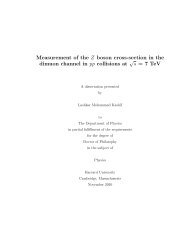2 The CDF Experiment at Fermilab Contents - Harvard University ...
2 The CDF Experiment at Fermilab Contents - Harvard University ...
2 The CDF Experiment at Fermilab Contents - Harvard University ...
Create successful ePaper yourself
Turn your PDF publications into a flip-book with our unique Google optimized e-Paper software.
56 Section 2: <strong>CDF</strong> Physics Analysis<br />
masses obtained with muon tracks. We concluded th<strong>at</strong> for <strong>CDF</strong> electron and muon<br />
tracks are essentially the same.<br />
We have also checked a number of interesting possibilities, all of which turn out to<br />
be insignicant. One is the Landau-Pomeranchuk-Migdal eect, which can suppress<br />
soft Bremsstrahlung. SLAC has measured this eect for 25 GeV electrons, and the<br />
amount of suppression shown by th<strong>at</strong> experiment does not signicantly change the<br />
E/p shape. We have also considered the possibility th<strong>at</strong> the 400 of aligned silicon<br />
crystals in the SVX may cause signicant energy loss for electrons traveling along an<br />
axis of symmetry. <strong>The</strong> E/p distribution for electrons which do not pass through the<br />
SVX looks the same as those which do, and we conclude th<strong>at</strong> this is not a signicant<br />
eect. <strong>The</strong> electron is being acceler<strong>at</strong>ed in a circle by the magnetic eld, and we are not<br />
simul<strong>at</strong>ing the resulting synchrotron radi<strong>at</strong>ion. This is predicted to be only a few MeV<br />
however, and can be safely neglected.<br />
We will use the Z mass to set the energy scale, as this avoids nearly all system<strong>at</strong>ic errors<br />
rel<strong>at</strong>ed to tracking. Nevertheless, the contradiction with E/p remains and is interesting in<br />
itself.<br />
We have also completed a model of the neutrino measurement. <strong>The</strong> missing E T measurement<br />
is domin<strong>at</strong>ed by the electron E T , but it also contains signicant contributions from<br />
energy unassoci<strong>at</strong>ed with the event, and also from the low energy particles which balance the<br />
W transverse momentum. We write U ~ for the vector sum of all the transverse energy in the<br />
event, excluding the electron energy E T . Instead of trying to model ~U from rst principles,<br />
we produce an empirical model which is t from Z d<strong>at</strong>a.<br />
<strong>The</strong> model tre<strong>at</strong>s U 1 and U 2 as independent, Gaussian random variables, where U 1 is ~U<br />
projected parallel to the boson, and U 2 perpendicular. <strong>The</strong> mean of U 2 is assumed to be<br />
zero, while the mean of U 1 varies with the boson P T . <strong>The</strong> vari<strong>at</strong>ion of the mean of U 1 with<br />
boson P T is t from the Z d<strong>at</strong>a. <strong>The</strong> widths of both variables are determined from the total<br />
energy in the event, and are also allowed to vary slightly with the boson P T . Figure 29 shows<br />
the U 1 and U 2 distributions of the d<strong>at</strong>a. For the gure, we have subtracted the predicted<br />
value for the mean of U 1 and divided by our predicted resolutions. <strong>The</strong> evidence th<strong>at</strong> our<br />
model is reasonable is th<strong>at</strong> both distributions correspond well to Gaussians centered on zero<br />
with unit widths.<br />
<strong>The</strong> P T distribution of Z's in the d<strong>at</strong>a is only known within the measurement resolution,















